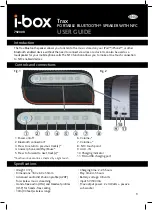
Dayton Audio
®
Last Revised: 5/13/2021
daytonaudio.com
tel + 937.743.8248
705 Pleasant Valley Dr.
Springboro, OH 45066
USA
5-Year Limited Warranty
See daytonaudio.com for details
Specifications
Model number:.......................... WP65WT
Description:............................... Commercial indoor/outdoor speaker
Woofer: ..................................... 6.5" mineral-filled polypropylene
Tweeter: .................................... 1" fabric
Frequency response: ................ 60-20,000 Hz
Impedance: ............................... 8 ohms/70V
70V/100V taps: ......................... 8 ohms/NC/20W/10W/5W/2.5W
Power handling (RMS/Peak): ... 40W/80W
SPL: .......................................... 87 dB / 88 dB @ 8 ohm setting, 2.83V/1m
Dimensions: .............................. 10-1/4" height, 8-1/8" diameter
Color: ........................................ White
Weight: ..................................... 4.2 lbs
Ingress protection rating: .......... IP66
3) Troubleshooting
Should your speakers not work properly, check the following:
No sound from speakers or quiet/strange sound:
•
Make certain you observed proper polarity for both speaker inputs. Check the
connections at the back of the receiver, and then at the speaker.
•
Verify that the amplifier is powered on and the volume is turned up.
•
Check that the correct transformer tap is selected for your application. If you
are using a stereo amplifier or a receiver, use the 8 ohm tap.
•
Mute feature or protection mode is activated. Check for short circuits in speak-
er wiring.
One speaker is playing while the other is not playing or plays quietly:
•
Check the balance control on the receiver. Make sure it is centered.
•
Loose connection at either the receiver or the speaker. Double check connections.
•
Bad speaker cable. Replace the suspect speaker cable.
Amplifier/Receiver cuts out:
•
This could be caused by a short circuit between the positive and negative
leads. Check the connections at the back of the receiver, and then at the
speaker; make sure that no strands of wire from one connector are touching
the other connector.






















